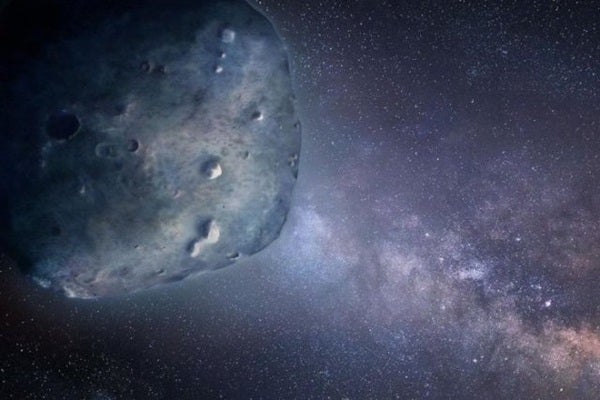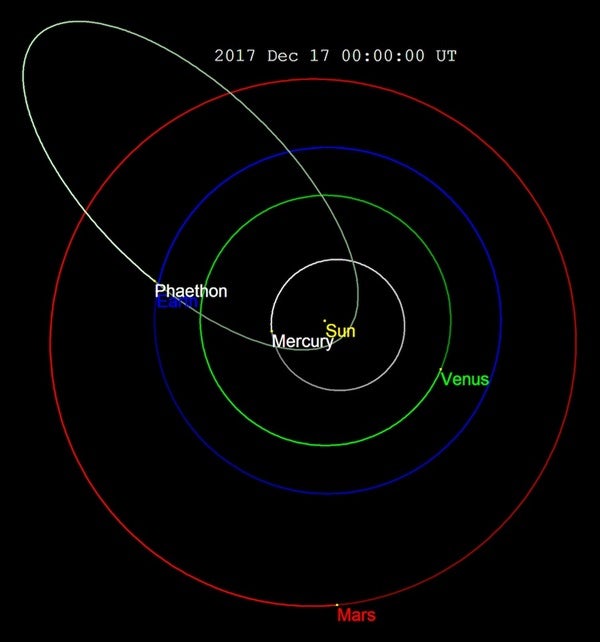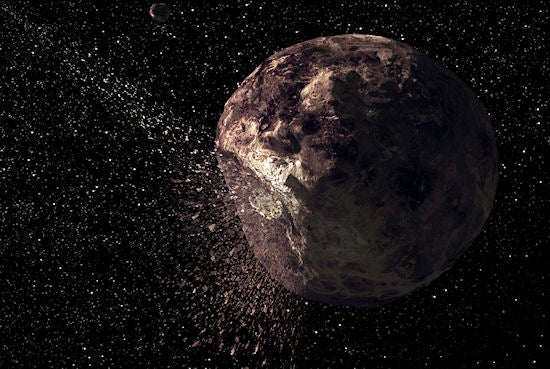Todorović’s interest in Pallas goes back to 2015, when she and her co-author Bojan Novaković explored orbital resonances in the region occupied by Pallas and its small family of asteroids. The path to the Pallas-Phaethon dynamical connection opened when she looked closely at the fine structure of a resonance between Jupiter and Pallas’s asteroid family — revealing a tantalizing clue about their bond.
Pallas the nonconformist
Discovered in 1802 by Heinrich Wilhelm Matthias Olbers, Pallas is 318 miles (512 kilometers) in diameter and the second asteroid ever discovered. The first was Ceres (now classified as a dwarf planet), which was discovered 14 months earlier by Giuseppe Piazzi (though Johann Elert Bode first suggested the existence of a Ceres-like object between Mars and Jupiter in 1772).
Pallas is a bit of an oddball in the asteroid belt. It’s one of just a few dozen so-called “B-type” asteroids — a primitive, carbon-rich class of asteroids often found in the outer asteroid belt. Their surfaces are dominated by anhydrous silicates, hydrated clay minerals, organic polymers, magnetite, and sulfide compounds. Though most asteroids follow orbits that lie near the ecliptic and have relatively low eccentricities. Pallas‘s orbit is inclined to the ecliptic (the orbital plane of the planets) by a whopping 34 degrees, and it has a large eccentricity (or deviation from a perfect circle) of 0.23. Pallas also has an unusual axial tilt of 84 degrees to its orbit, meaning its rotation axis is nearly parallel to its orbital plane.
For over a century, the origin of the Geminids remained a mystery. Nearly all meteor showers originate from streams of debris (called meteoroids) shed by comets as they circle the Sun. For example, Halley’s Comet is the parent of the Orionids and the Eta Aquarids. The Leonids originate from Comet 55P/Tempel-Tuttle. And the prolific Perseids come from Comet 109P/Swift-Tuttle. But no known comet had an orbit even close to that of the Geminid’s meteoroid stream.
Son of Helios
Then, in 1983, astronomers discovered an NEA that was later named 3200 Phaethon, in honor of the son of the Greek sun-god Helios. Phaethon is a rather peculiar little object. For starters, its orbit is tilted at an angle of 22.2 degrees to the ecliptic. It also has a highly elongated orbit; with an eccentricity of 0.88, its orbit is more like a comet than an asteroid. Astronomer Fred Whipple soon noticed that Phaethon’s orbit is nearly identical to those of many photographed Geminid meteors. In 2010, David Jewitt and Jing Li observed Phaethon ejecting tails of dust — the source of the Geminids.
This rotating view of asteroid 3200 Phaethon was made using radar images captured by astronomers using Arecibo Observatory on December 17, 2017.
Arecibo Observatory/NASA/NSF
The dust is literally cooked off Phaethon’s surface. “When Phaethon passes through its perihelion,” said Todorović in an email interview with Astronomy, “it gets within 20.9 million km [13 million miles] of the Sun,” closer than any other named object in the solar system including Mercury. “It heats up to almost 1000 K. 262 days later, Phaethon is 359 million km [223 million miles] away from the Sun, far beyond the orbit of Mars. There it cools down to very low temperatures. This constant periodical cooling and heating cycle cracks its mineralogical surface into small dusty particles. Each December, when Earth passes close to the orbit of Phaethon, the small grains swept from Phaethon by the radiation pressure (of sunlight) enter our atmosphere as the Geminids.”
Like Pallas and the Palladians, Phaethon has a highly inclined orbit, and is also a B-type asteroid. But could Phaethon migrate from a Palladian family-like orbit in the main belt to a comet-like orbit that nearly grazes the Sun and swings past Earth? And if so, how?
Dynamical highways
Todorović nailed down the Phaethon-Pallas connection by probing the chaotic complexities of orbital resonances. These “are places in our solar system responsible for the transportation of small bodies, something like dynamical highways,” she explained. Astronomers have long known that there are areas in the asteroid belt — called Kirkwood gaps after the astronomer who first noticed them — that are almost completely empty of objects. These regions, said Todorović, have been cleared out by orbital resonances moving small bodies away. “Jupiter, the most massive planet, produces the strongest ones,” Todorović explained. “One is the 5:2 mean-motion resonance with Jupiter, which is approximately 2.8 AU [1 AU is the average Earth-Sun distance] from the Sun,” in the middle of the asteroid belt. “We call it 5:2 because this is a place where asteroids make five orbits around the Sun while Jupiter makes two.”
Imagine the situation, said Todorović, where an asteroid and a planet are orbiting the Sun, and the mutual distance between them is smallest at the same point on their respective orbits. When this alignment repeats periodically (and always occurs at the same point), the asteroid and the planet are in an orbital resonance. However, the effects of gravitational interactions between them will begin to accumulate over time, and the smaller body (in this case, the asteroid) will eventually be moved out of its orbit.
“Being in a resonance can have dramatic results for an asteroid,” said Todorović. “It can collide with a planet, fall into the Sun, or even be ejected from the solar system. Or the asteroid may spend some time trapped in the resonance” until it’s peacefully moved away to another part of the solar system. Could this be what happened to a member of the Palladian family — a smallish fragment of Pallas was caught in a gravitational whirlpool and flung into a new orbit?
This time-lapse showing the motion of asteroid Phaethon through the sky was captured by amateur astronomer Ingvars Tomsons from Riga, Latvia.
Ingvars Tomsons/Kobalts/Wikipedia
Mapping the highways
Researchers can use powerful computers and mathematical tools to play “what-if” with simulated Palladians moving through the asteroid belt’s Jovian 5:2 mean-motion resonance (MMR). In 2010, Julia de Leon of the Instituto de Astrofisica de Canarias and her colleagues followed the evolution of simulated orbits for a thousand virtual Pallas fragments that passed through the 5:2 and 8:3 MMRs with Jupiter. Over a period of 100 million years, most ended up in the Sun or ejected into interstellar space. But not all. About 2 percent ended up in Phaethon-like NEA orbits.
They also compared the spectra of Phaethon with Pallas, the Palladian family asteroids, and all the other B-type asteroids in the belt. Phaethon turns out to have a visible spectrum very similar to those of the Palladian family objects — and unlike any other B-type asteroid in the main belt.
A 2 percent probability is always greater than zero. But it’s still miniscule. Todorović took a closer look. Like de Leon and her colleagues, said Todorović, “we took test objects, placed them into the resonance close to Pallas, and observed where the test objects would go in the following millions of years.”
Inclination and lines of chaos
But Todorović used more realistic orbital inclinations and took “snapshots” of chaos inside the resonance region. “I ‘took a photo’ of the 5:2 resonance, a ‘dynamical map,’ where I could see clearly the exact shape of the resonance. Then I ‘zoomed in’ on the part of the resonance where the fragments of Pallas were injected.” By doing this, she could tease out the fine structure of chaos in the resonance. Todorović then ran computer simulations of how their orbits evolved over 5 million years.
“The practical role of these fine lines of chaos is that they provide fast transportation routes. I chose all the test object along the fast transportation roads. The [simulated fragments] were initially placed at the most unstable parts of the resonance were very quickly pushed away by the resonance.”
The result? The simulation, which included the effects of chaos in the resonance regions, showed that about 44 percent of the simulated Pallas fragments placed in the 5:2 MMR ended up in Phaethon-like orbits. The first fragments reached Phaethon’s orbit in less than 300,000 years. The median delivery time was 1.7 million years. For fragments that started from the 8:3 MMR, nearly 47 percent arrived in Phaethon’s orbit within 5 million years. The first ones took a little over half a million years.
Todorović also used more realistic orbital inclinations for her test fragments. “In a previous study, I used initial particles at low orbital inclination but still in the 5:2 MMR,” she explained. “In that experiment, only 8 percent reached the orbit of Phaethon…. Increasing the inclination of the test objects from 10 to 35 degrees” — the inclination of Pallas — “improved the efficiency of the transportation.”
Blasted free millions of years ago, rerouted into a near-Earth orbit by a resonant gravitational highway, its surface pulverized into dust by eons of fry-and-freeze cycles, the source of the Geminid meteor shower is itself a broken piece of Pallas.













